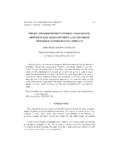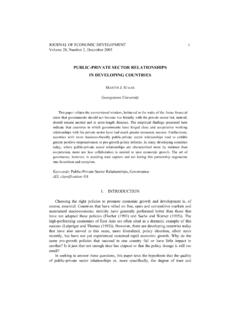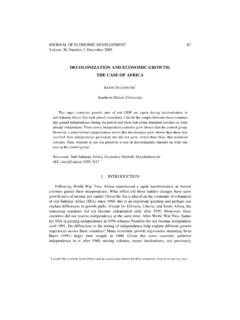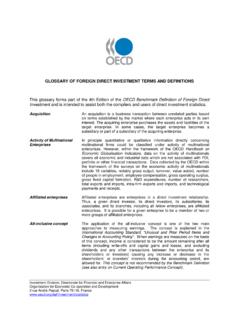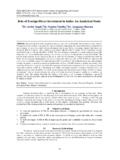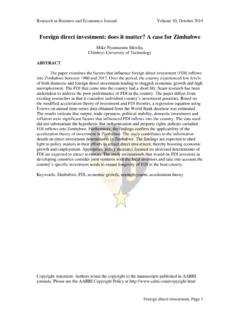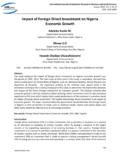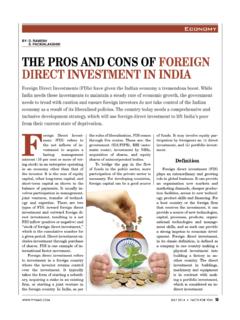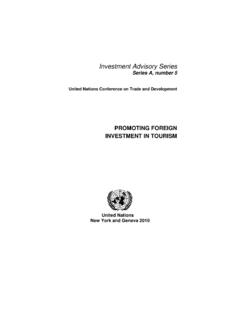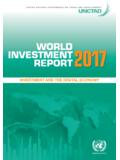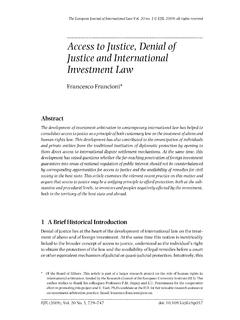Transcription of EVALUATING THE IMPACT OF FOREIGN AID ON …
1 JOURNAL OF economic DEVELOPMENT 25. Volume 30, Number 2, December 2005. EVALUATING THE IMPACT OF FOREIGN AID ON economic . growth : A CROSS-COUNTRY STUDY. SANDRINA BERTHAULT MOREIRA*. College of Business Administration Set bal Polytechnic One branch of the literature on aid effectiveness attempts to measure the contribution of FOREIGN aid to the growth of developing countries. The micro results are clear and encouraging: FOREIGN aid is beneficial to economic growth . However, until recently, the macro results were inconclusive: the IMPACT of aid on growth was positive, negative, or even non-existent, in statistical terms. This contradiction is known as the micro-macro paradox . Certain methodological and econometric flaws inherent in the assessments being carried out up to the mid-nineties may provide an explanation for the misleading macro results.
2 Examining a large panel data set, I have found that FOREIGN aid has had a positive IMPACT on economic growth . In light of these findings, I conclude that earlier-generation work is in accordance with the new and recent generation of aid effectiveness studies. Thus, less importance should be attributed to the micro-macro paradox as an overall appraisal of aid effectiveness. In terms of magnitude, I have also found that aid has less effect on growth in the short-run than in the long-run. I also conclude that the time lags in the aid- growth relationship should not be ignored. Keywords: FOREIGN Aid, economic growth , Panel Data, Generalised Method of Moments JEL classification: F35, O11, O40, C23. *. I am especially grateful for remarks and comments from an anonymous referee, Finn Tarp, Jochen Oppenheimer, and Jos Passos.
3 The unpublished work of Hansen et al. (1998) has been kindly provided by Finn Tarp, who is acknowledged for. Earlier versions of this paper were presented at the 15th Annual Meeting on Socio-Economics, by SASE and LEST, Aix-en-Provence, France, June 2003 and the 7th Conference on Mathematics Applied to Economics and Management, by CEMAPRE, Lisbon, Portugal, September 2003. I. would like to thank panel participants for comments. 26 SANDRINA BERTHAULT MOREIRA. 1. INTRODUCTION. Official development assistance (ODA), more commonly known as FOREIGN aid, consists of resource transfers from the public sector, in the form of grants and loans at concessional financial terms, to developing countries. Many studies in the empirical literature on the effectiveness of FOREIGN aid have tried to assess if aid reaches its main objective, defined as the promotion of economic development and welfare of developing countries.
4 When focusing on the traditional purpose of FOREIGN aid - promotion of the economic growth of developing countries -, one notes that the results obtained differ according to the approach used. Studies at the micro-level, mainly using cost-benefit analyses, support the view of those in favour of the effectiveness of FOREIGN aid. In contrast, the results presented in studies at the macro-level, namely cross-country regression studies, are, to say the least, ambiguous. Mosley (1986) called this contradiction the micro-macro paradox . The official announcement for a move towards selectivity in allocating development assistance gave new impetus to the discussion about aid effectiveness. As a result, a number of econometric studies linking economic growth to FOREIGN aid have been published in the last few years.
5 Compared to previous work, they break new ground in the field. Panel data econometric tools have been employed to allow for non-linear effects of aid on growth and the endogeneity of aid and other variables. Furthermore, these recent studies have been inspired by the new growth literature, which encompasses various modifications to the Solow-Swan neoclassical growth model and endogenous growth models, which in turn provides a different analytical basis compared to earlier work. The third-generation of cross-country regression studies, as it is known, with it's advances in theory and method, have achieved the macro results foreseen by those in favour of the effectiveness of FOREIGN aid and, therefore, the micro-macro paradox ceases to exist. Even so, the widespread perception that a disparity exists between micro and macro results reported by former studies is still very much alive.
6 This paper concentrates on the aid- growth relationship at the macro-level. An overall analysis of cross-country regression studies published from the late sixties to the mid-nineties reveals that whether the dependent variable is savings, investment or economic growth , the ODA regressor is sometimes significantly positive, sometimes significantly negative, and sometimes even non-significant, in statistical terms. That is, the contribution of FOREIGN aid to the economic growth of developing countries may be positive, negative, or even non-existent, in statistical terms. The explanation for the inconclusive results remains unclear, but many authors have suggested theoretical and/or methodological and econometric causes. The underlying theory of the macro studies in focus here assumes that physical capital accumulation is the key to economic growth .
7 However, advances in growth theory have come to show that the growth process relies on a complex set of interdependent factors. In other words, a host of other factors besides physical capital EVALUATING THE IMPACT OF FOREIGN AID ON economic growth 27. accumulation is known to affect growth . Therefore, according to many authors, the Harrod-Domar growth model and the Chenery and Strout two-gap model are over-simplified. The econometric aid- growth literature has been also criticised on several grounds. Indeed, after a careful study of twenty-nine macro studies, I have recorded a number of methodological and econometric weaknesses that may explain the inconsistent results of regression studies. Therefore, this paper assesses the macroeconomic IMPACT of FOREIGN aid on the economic growth of developing countries, and proposes improvements to the methodological and econometric procedures found in studies of the aid- growth relationship.
8 growth regressions, based on a large sample of developing countries covering a 29-year period, are estimated using the generalised method of moments (GMM) suggested by Arellano and Bond (1991). The remainder of the paper is organised as follows. Section 2 briefly presents the theoretical basis for the cross-country regression studies on aid effectiveness reviewed in Section 3. Section 4 describes the main features of my empirical study, namely methodology framework, model specification, data and variables, followed by the analysis of the estimated results in Section 5. Section 6 briefly presents the new generation of cross-country regression studies and Section 7 this author's conclusions. 2. HARROD-DOMAR MODEL AND GAP MODELS. Empirical studies of the aid- growth relationship carried out until the mid-nineties were influenced by the early growth theories, which asserted that the growth process depends on the ability to surpass the constraints regarding the accumulation of physical capital.
9 Investment was perceived as the key to economic growth . Traditionally, the lack of savings crucial to investment was regarded as the most important limitation to the economic growth of developing countries. Indeed, one characteristic of developing countries is their limited capacity to generate savings, due to their low per capita income. The original Harrod-Domar model was expanded in the sixties in the Chenery and Strout (1966, 1979) two-gap model. The FOREIGN exchange shortage was introduced as another possible growth constraint. Typically, developing countries need to import goods and services, vital to investment and production; but import requirements usually exceed export earnings. Investment can be constrained either by a shortage of domestic savings (the savings gap) or by a shortage of exports earnings (the trade gap).
10 Therefore, FOREIGN aid inflows in particular, and FOREIGN capital inflows in general, are needed to fill the prevailing gap, so that countries can grow more rapidly than their internal resources would otherwise allow. If these inflows do not exist, the country will experience slower growth and inefficient employment of internal resources (labour and natural resources). The desirable outcome is self-sustaining growth . Following the crippling debt crisis of the 1980s, Bacha (1990) and other 28 SANDRINA BERTHAULT MOREIRA. neostructuralist authors, like Lance Taylor, introduced a third fiscal gap between government revenue and expenditures. The three-gap model predicts that government budget limitations rather than FOREIGN exchange constraints or an overall savings restriction, may be binding.
